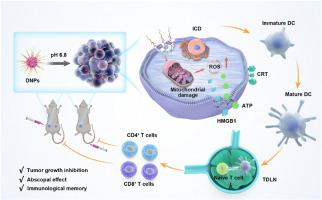用于溶瘤免疫疗法的肿瘤微环境激活多肽纳米颗粒。
IF 12.9
1区 医学
Q1 ENGINEERING, BIOMEDICAL
引用次数: 0
摘要
阳离子溶瘤多肽能够直接裂解癌细胞并激活强大的抗肿瘤免疫力,因此越来越受到关注。然而,溶瘤多肽对肿瘤细胞的低选择性和正电荷引起的固有毒性阻碍了它们的全身应用。本文通过静电相互作用,将阳离子溶瘤多肽(PLP)与对 pH 值敏感的阴离子多肽自组装,开发出一种肿瘤微环境响应纳米粒子(DNP)。DNP 形成后,PLP 的正电荷被屏蔽。DNPs 可在生理条件下(pH 值为 7.4)保持稳定,但会对酸性肿瘤微环境(pH 值为 6.8)做出反应,释放溶瘤 PLP。因此,DNPs 通过破坏细胞膜、损害线粒体和增加细胞内活性氧水平,诱发强效免疫原性细胞死亡。体内研究结果表明,DNPs 能显著改善 PLP 的生物相容性,并通过直接溶瘤和激活抗肿瘤免疫反应抑制肿瘤生长、复发和转移。总之,这些结果表明,对 pH 值敏感的 DNPs 是改善阳离子聚合物用于溶瘤免疫疗法的肿瘤选择性和生物安全性的一种前瞻性策略。本文章由计算机程序翻译,如有差异,请以英文原文为准。

Tumor microenvironment-activated polypeptide nanoparticles for oncolytic immunotherapy
Cationic oncolytic polypeptides have gained increasing attention owing to their ability to directly lyse cancer cells and activate potent antitumor immunity. However, the low tumor cell selectivity and inherent toxicity induced by positive charges of oncolytic polypeptides hinder their systemic application. Herein, a tumor microenvironment-responsive nanoparticle (DNP) is developed by the self-assembly of a cationic oncolytic polypeptide (PLP) with a pH-sensitive anionic polypeptide via electrostatic interactions. After the formation of DNP, the positive charges of PLP are shielded. DNPs can keep stable in physiological conditions (pH 7.4) but respond to acidic tumor microenvironment (pH 6.8) to release oncolytic PLP. As a result, DNPs evoke potent immunogenic cell death by disrupting cell membranes, damaging mitochondria and increasing intracellular levels of reactive oxygen species. In vivo results indicate that DNPs significantly improve the biocompatibility of PLP, and inhibit tumor growth, recurrence and metastasis by direct oncolysis and activation of antitumor immune responses. In summary, these results indicate that pH-sensitive DNPs represent a prospective strategy to improve the tumor selectivity and biosafety of cationic polymers for oncolytic immunotherapy.
求助全文
通过发布文献求助,成功后即可免费获取论文全文。
去求助
来源期刊

Biomaterials
工程技术-材料科学:生物材料
CiteScore
26.00
自引率
2.90%
发文量
565
审稿时长
46 days
期刊介绍:
Biomaterials is an international journal covering the science and clinical application of biomaterials. A biomaterial is now defined as a substance that has been engineered to take a form which, alone or as part of a complex system, is used to direct, by control of interactions with components of living systems, the course of any therapeutic or diagnostic procedure. It is the aim of the journal to provide a peer-reviewed forum for the publication of original papers and authoritative review and opinion papers dealing with the most important issues facing the use of biomaterials in clinical practice. The scope of the journal covers the wide range of physical, biological and chemical sciences that underpin the design of biomaterials and the clinical disciplines in which they are used. These sciences include polymer synthesis and characterization, drug and gene vector design, the biology of the host response, immunology and toxicology and self assembly at the nanoscale. Clinical applications include the therapies of medical technology and regenerative medicine in all clinical disciplines, and diagnostic systems that reply on innovative contrast and sensing agents. The journal is relevant to areas such as cancer diagnosis and therapy, implantable devices, drug delivery systems, gene vectors, bionanotechnology and tissue engineering.
 求助内容:
求助内容: 应助结果提醒方式:
应助结果提醒方式:


